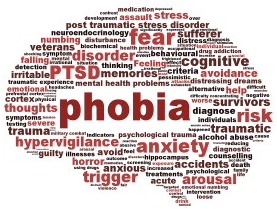 One in four of us will have a phobia impacting our lives. In less than five hours, this fear can be removed. A phobia is defined as, “an extreme or irrational, persistent fear of a situation or object.” For example, a fear of flying, needles, heights, or dogs.
One in four of us will have a phobia impacting our lives. In less than five hours, this fear can be removed. A phobia is defined as, “an extreme or irrational, persistent fear of a situation or object.” For example, a fear of flying, needles, heights, or dogs.
A fear of spiders for someone living in Australia is not irrational, because dangerous spiders do exist, but having a fear of domestic British house spiders that can’t hurt you, could be deemed a phobia. If your fear is negatively impacting on your life, you might find yourself not being able to do something important, for example, using a needle as a nurse or unable to climb a ladder as a fireman. If this is the case, then it may be time to seek professional help and get your life back on track.
Many people choose to live with their phobia because it never or rarely impacts their lives. People choose to remain scared of heights or afraid of dogs and avoid putting themselves in situations where they may confront their fear. Unfortunately, avoidance behaviour only serves to maintain this fear.
In psychology, phobias come under anxiety disorders, along with panic attacks, obsessive compulsive disorder (OCD), generalised anxiety and post-traumatic stress, to name but a few. According to Kessler’s research in 2005, nearly 79% of the population will suffer from one form of anxiety disorder during their life, with specific phobias (12.5%) and social phobias (12.1%) the largest groups.
How to treat phobias
The good news is that phobias can be treated effectively. One recommended form of treatment with excellent recovery rates is Cognitive Behavioural Therapy (CBT), a talking therapy that can help you manage your problems by changing the way you think and behave. It is most commonly used to treat anxiety and depression, but can be useful for other mental and physical health problems. Using cognitive behavioural therapy (CBT), recovery rates are between 80-90% in the UK, and a general rule, the more effort you put in, the better the results will be.
CBT is ‘evidence based’ and provides a really clear structure of treatment for the patient. At Talk For Change, our process has three parts:
1. Pre-treatment – assess the basis of your fear, thoughts, feelings and behaviour – 75 mins
2. Actual treatment – face your fear – about 3 hours (not usually in one session)
3. Post-treatment – review progress and create your maintenance plan – 30 mins
All treatment starts with a pre-treatment interview, typically 60-75 mins with your therapist to fully assess your condition; to understand why you are scared and what you think will happen when you come into contact with your particular phobia. CBT is an excellent way of ‘slowing down the process’ so you can make sense of how you are feeling. You will work with your therapist to identify which behaviours are the most problematic and get exposed to your fear through a series of experiments. These experiments are designed to see which behaviours help or hinder your recovery.
This is a crucial part of treatment that enables you to identify behaviours that maintain how you are currently feeling and reinforce your beliefs linked to your fear. Avoiding the problem is a natural reaction but not helpful in trying to overcome your phobia. The best way to achieve success is to face your fear! At Talk For Change, and all other IAPT services, this is how we help people get their lives back.
The process
The research of Professor Lars-Göran Öst, at Stockholm University, has been the primary driver in being able to significantly and totally remove the impact of phobias on a patient’s life. As a patient you will be asked to imagine you’re in the worst phobic situation, one where you are unable to escape. Your therapist will ask you…
• What is the worst consequence as a result of this encounter?
• On a scale (0-100%) how convinced are you of having strong anxiety when in this situation?
• It’s important you rate your conviction when sitting in the therapist’s office talking rationally
Consider this example, a fear of snakes:
Therapist T: What is the worst thing you fear that will happen when you encounter a snake?
Patient P: I don’t know. I’ll scream and run away.
T: Imagine that you cannot run away?
P: I would freeze and just stare at the snake.
T: What do you think that the snake would do?
P: It would wriggle over to me, up my legs, underneath my clothes and bite me.
T: What would happen to you then?
P: I would die.
T: How would you die?
P: From the snake’s venom.
T: What if the snake isn’t a venomous snake?
P: I die from the shock. My heart wouldn’t stand it.
T: Okay. The worst that you imagine could happen is that you will die. How convinced are you (0-100%) in the situation, when you are in contact with the snake that it will lead to your death?
P: 100%.
T: And how convinced are you now when you are sitting here talking rationally to me about it?
P: 30%
The objective is to normalize the patient’s phobic behaviour, which is nearly always characterised by catastrophizing the situation. As in the example above, the snake will bite me and I will die, even if it isn’t a venomous snake!
 Because patients believe so strongly in the catastrophe, they will avoid or run away from the object of their phobia in order to escape the anxiety it provokes in them. This stops the patient from obtaining new information and new experiences that can correct the false belief in catastrophe. This pattern of learned behaviour means that the phobia remains unchanged.
Because patients believe so strongly in the catastrophe, they will avoid or run away from the object of their phobia in order to escape the anxiety it provokes in them. This stops the patient from obtaining new information and new experiences that can correct the false belief in catastrophe. This pattern of learned behaviour means that the phobia remains unchanged.
A therapist will tailor the description of the treatment to the individual patient’s problem behaviours. The purpose of treatment is to expose the patient to the phobic situation in a controlled way, with the therapist working together in a team with the patient. Gradually, the exposure shifts from the therapist, to the patient being in full control. There is a magical feeling, when someone who cannot function normally because of their irrational fear, confronts their fear head on, and within a very short period of time is handling the fear.
The most successful treatments should be seen as the start of something that the patient should continue on his/her own. Maintenance is vital to manage the fear. If you feel it’s time to overcome your fear, contact your GP or IAPT service (IAPT stands for Improving Access to Psychological Therapy) and is a nationwide NHS service. If you live in Milton Keynes contact us on 01908 228830 option 4 or email us support@talkforchange.org.uk






